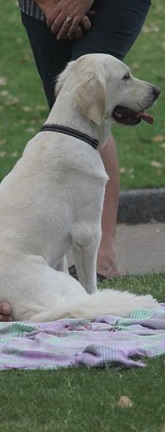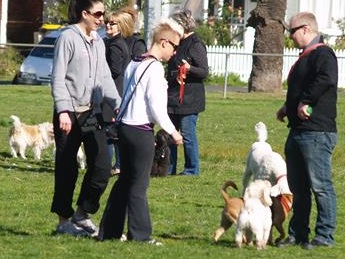Discover how dogs think... and it's not like humans!
 Understand what your dogs training needs are and accomplish them.
Understand what your dogs training needs are and accomplish them.
- Manage your pets more effectively whether at home, during travel, on walks, or when your dog is left home alone.
- Communicate better with your dogs - relive their anxieties and your own frustrations.
- Further business or career prospects in the pet industry - diversify your income from pet care or health to become a specialist animal behaviour advisor.
A well adjusted, sociable dog is a joy to have around the whole family.
COURSE STRUCTURE AND CONTENT
There are 9 lessons in this course:
- Nature and Scope of Canine Psychology
- A brief history of the canine evolution.
- Self-domestication.
- Canine industries.
- Canine Senses
- Understanding canine communication.
- Sight.
- Body Language.
- Smell.
- Sound.
- Elimination Postures.
- Understanding Natural Canine Behaviour
- Social Structure.
- Social Behaviour.
- Aggression.
- Clinical Problems.
- Biological Rhythms.
- Sleep.
- Sexual Behaviour.
- Maternal Behaviour.
- Parturition.
- Suckling and Weaning.
- Eating and Drinking.
- Canine Behavioural Development
- Nurture.
- Sensitive Periods.
- Neurological Development.
- Canine Temperament Testing.
- How Breeds Differ.
- Canine Behavioural Disorders
- Attention Seeking Behaviour.
- Excessive barking.
- Chewing.
- Running away.
- Chasing moving objects.
- Begging.
- Digging.
- Separation anxiety.
- Aggression.
- Phobias.
- Excessive compulsive disorders.
- Cognitive Dysfunction.
- Calming a dog.
- Basic Dog Training

- Forming habits.
- Conditioning.
- Classical Conditioning.
- Operant Conditioning.
- Socialisation.
- House training.
- The use of visual signals.
- The use of voice commands.
- The use of training aids.
- Dog Obedience Training
- Practical Training Techniques.
- Recall.
- Sit.
- Stand.
- Drop.
- Leave.
- Down.
- Stay.
- Heel.
- Seek.
- Retrieve.
- Bark on Signal.
- Controlling a Dogs Movement
- Territorial nature of dogs.
- Fencing.
- Dog doors.
- Kennels.
- Exercise requirements.
- Socialisation requirements.
- Walking on a lead/leash.
- Electronic barriers.
- Microchips.
- Pet Registration and Licensing.
- Controlling Killing Wildlife.
- Training Working Dogs
-

Training for scent discrimination or substance detection.
- Training for retrieving.
- Guarding.
- Hearing dogs.
- Herding.
- Tracking.
- Controlling attacks on animals and people.
Each lesson culminates in an assignment which is submitted to the school, marked by the school's tutors and returned to you with any relevant suggestions, comments, and if necessary, extra reading.
AIMS
 Describe how canine animals think and discuss the relevance of understanding canine psychology to people.
Describe how canine animals think and discuss the relevance of understanding canine psychology to people.- Explain how canine animals communicate and formulate an understanding of possible ways that a human may communicate with a dog.
- Understand behaviours that are natural and predictable in canines and learn to recognise and understand signals that dogs give.
- Explain how dogs develop behavioural characteristics throughout stages of their life.
- Describe commonly occurring behavioural problems in dogs.
- Develop a program for training a new pet dog when it is brought into a household.
- Explain how to train a dog to perform predetermined actions upon command.
- Describe how the movement of dogs can be controlled, both through training and other methods.
- Describe how dogs can be trained to perform tasks required as a working dog, including a sheep dog, tracking dog, blind dog or substance detection dog.
You will complete at least one task and an assignment for each lesson. You will need to have access to dogs to observe them and practice the training techniques taught in the course.
LEARN DOG TRAINING
How to Get Dogs to Drop or Release
Dogs like to pick things up. Hurley who we mentioned earlier loves to pick up socks left in the washing. He runs away with them and hides them in his basket. If he is caught and told to drop them, he will, however, not all dogs will release things. They may pick up something they should not, like a toy, or sock, or food. Or they may have their ball and not want to give it back so the owner can throw it. Taking things from a dog’s mouth, and in particular food, can be risky. We would only recommend doing this if you are very sure of the dog and the dog’s temperament.
Being able to take food out of the mouth of a dog is an important indicator of hierarchical pack mentality and your place within it. As an owner or handler, you should be able to take food out of the mouth of your dog, as you should be the ‘alpha’ pack member in your dog’s mind, thus it should be submissive to you. We do not recommend you try this without careful knowledge of the dog, its behaviour and a deep understanding of pack order. Even the smallest dog breeds can have a nasty bite, and pet dogs will naturally follow their instincts to protect their food item.
For the purposes of this technique, we will assume we are asking the dog to a release a ball from its mouth.
Technique for drop (release):
- Call your dog’s name to gain their attention and use the RECALL command.
- From a sitting position with the dog facing you and with the item (ball) in the dog’s mouth, bring your right hand containing a small food treat in front of the dogs nose but not touching it.
- The dog will naturally lean forward sniffing the treat from your hand, when the nose touches your hand, open your clasped hand to reveal the treat.
- Your dog should release the ball from its mouth as it take the treat from your hand, as soon as it releases the ball give the DROP command.
- Reinforce by giving the dog a small treat immediately.
- Take the ball in your left hand and move your right hand back into the position beside your waist.
- Repeat a number of times and with many different items.
- Then again rewards should reduce until they are used only as random re-enforcers.
Working with Dogs
Dogs fill a variety of roles in our current human society. Working dogs can carry out a variety of jobs from herding sheep, helping the lives of disabled and blind people, to seeking out and detecting explosives and drugs.
In most countries around the world, the most common role of domesticated dogs is as a companion animal to humans. There are a wide variety of ancillary industries that rely on this companion animal market.
Some examples include:
- breeding enterprises
- grooming enterprises
- training enterprises
- boarding or kennel enterprises
- walking and pet sitting
- pet shops sell a range of products and equipment
- canine behaviour therapists
- complementary medicines and therapies
OTHER COURSES THAT MAY INTEREST YOU
eBOOK AVAILABLE - supplementary reading to assist you cover all aspects of dog care, health, feeding and more. Ideal for a new business start-ups!
Caring for Dogs - ebook
In every component of life, dogs have accompanied humans. In war, in sport, in hunting, in scientific discoveries, in work, in wealth and in art, dogs have been cooperating with humans. Nowadays there are many dogs whose lives have meaning and purpose beyond companionship; however the majority of dogs over the world are pets living in homes as much loved family members. They offer companionship, love and loyalty. The dog remains deeply a part of human life and our best friend.
ARE YOU THINKING WHAT NEXT?
Register to Study - We Have Daily Intakes - Start Today!
OR
Ask us questions, we have answers. Email info@acsedu.co.uk
OR
Use our FREE COURSE COUNSELLING SERVICE to contact a tutor or enrolment advisor
CLICK TO CONTACT US